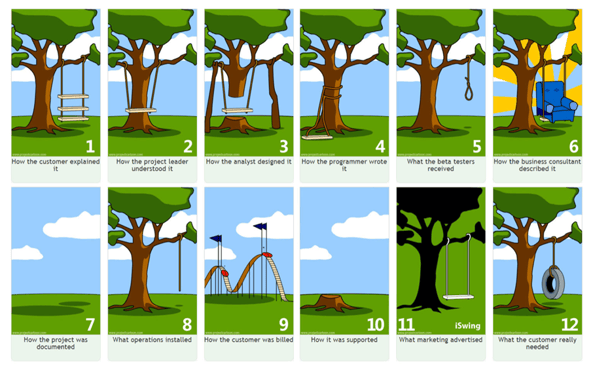Steve's Scribblings - When it comes to education & elections, history teaches us that…
It’s happened twice in my educational career. The elections of 1997 and 2010 featured governments of long-standing being overturned (18 years of...

New Year, New Resolution... “I’m going to make sure that this year’s ICT Change project goes well”,
but how? You might have made that resolution before but ended up with a variety of the problems
shown below..

Tree Swing analogy. Source
Seven of the schools and colleges that were put under the microscope for the Research Report Implementation of education technology in schools and colleges (published in September 2022 by the DfE) used a range of tools and frameworks to help them get things right. Whilst these tools are mentioned in the Informed Decision-Making section of the report (section 3), the reality is that they can be used across all stages of an EdTech implementation project. The tools/frameworks are a mixture of industry/context-specific and generic management tools – with some using more than one for different elements of the process. Here’s a summary of the tools and how they were used.
Education Endowment Foundation (EEF)
The EEF’s mission very much puts the research/evidence-driven change at the heart of school improvement. Their Putting evidence to work: A school’s guide to implementation initiative includes a guidance report on exactly this and includes a range of tools and an online programme. Not EdTech-focused, but a useful starting point especially if you’re working to apply this model to other areas of change within your organisation.
Education and Training Foundation (ETF) Digital Teaching Professional Framework
The framework was designed to help the Further Education (FE) and Training workforce to become confident and effective users of technology in teaching and learning by focussing on the benefits of good pedagogy supported by technology to enhance learning. The DfE EdTech Research Report discusses how it was used to support the implementation and embedding of a communication platform to be used by staff and learners throughout an FE College.
Microsoft Education Transformation Framework (METF)
It should be no surprise that EdTech features in this framework, but Microsoft consciously focus on a more holistic transformation agenda, where system-wide transformation is the focus. The 4 pillars of the Framework are:
This Framework isn’t about on-going project management but more about helping you to get off on the right foot.
5Ts model (Trigger, Test and Trial, Trust, Train, Track)
This model has been adopted as a five-stage approach to implementing EdTech by a large MAT. The model can be applied across sectors and works for different sizes of project.
Trigger: A request is made to trigger a test, for example, of a cloud-based tool. This might be based on a need (of one or more schools, or a MAT-wide need), or could be a piece of EdTech that is considered as potentially beneficial to ongoing student and Trust improvements.
Test: The request is considered by a team of technology leads (teachers with technology expertise in schools across the MAT) and one or more will take responsibility for exploring options. The selected technology will be tested initially if required, for example with a small group of teachers representing a range of technology capabilities, and their learners. Understand more about piloting by downloading our guide ‘Why and how you should run an EdTech pilot’
Trial: If the tested EdTech is considered to be of value, it will be supported as recommended technology and made available at a MAT level. This can lead to wider roll-out, subject to MAT procurement processes.
Train: Once recommended, training is provided by the MAT technology leads and/or external companies so that staff and learners become confident users and are able to get the most out of the technology.
Track: Finally, the implementation, embedding and impact of the EdTech is monitored, evaluated and any improvements made.
The BECTA self-review framework
BECTA – once-upon-a-time Government quango focusing on all things ICT and Education – had a profound impact in the Noughties. Although BECTA no longer exists, it is still a useful framework when reviewing Edtech development in a school. It has eight themes to follow which enable schools to identify and quantify the issues that need an up-to-date EdTech solution.
NAACE self-review framework
The Edtech community recognised the impact of BECTA’s work and NAACE developed a ‘maturity model’ Self-Review Framework which helps schools to:
This Framework is updated regularly and has been used successfully by 100s of schools.
SWOT Analysis
A Strengths-Weaknesses-Opportunities-Threats analysis is a fairly ubiquitous element in improvement projects in organisations across all sectors. It’s quick and easy, but depends on contributors for its insightfulness. Again – more of a pre-project tool to ensure that you have the correct ‘diagnosis’ before you develop the ‘treatment’.
Cost-Benefit Analysis (CBA)
Great for helping to compare different solutions, the DfE Report records how a CBA was used to help a school decide between different device options to pilot. Usually, the elements of a CBA are:
Rapid Application Development (RAD)
This is an adaptive software development model and was used by a secondary school within a large MAT for trialling and implementing a tool for producing dynamic, one click reports on MIS and behavioural data. The process involved repeated cycles of development, testing and feedback, adapting the software programming with each cycle to develop bespoke reports for different departments within the school. Not a model that can be applied to all EdTech projects, it clearly met requirements in this instance.
I’ve highlighted many different tools, that were referenced within the DfE’s EdTech Report, which are best suited to different stages of an EdTech or change programme. I’m not advocating using them all, it’s about selecting the frameworks/tools that will support you and facilitate your project the best at each stage. The report highlights feedback from a secondary school leader which again reinforces the need to understand not only your organisation’s EdTech situation, but also the wider context.
“You need to use some sort of digital transformation framework to move forward at a whole school level. It’s not just about the tech, but the environment and processes. […] You have got to [use a framework] as it forces you to reflect and consider some areas you might not naturally think about.” – Senior leader, Secondary school
Before you embark on your next EdTech project, both large or small, I encourage you to take a step back before you plunge in and consider if you have a solid framework to follow and tools which will help ensure success and not have a project that looks like any of the pictures above.
If you feel that you need some guidance on your ICT EdTech or don’t have the capacity to run the project, get in touch - we can help.

It’s happened twice in my educational career. The elections of 1997 and 2010 featured governments of long-standing being overturned (18 years of...
.jpg)
Immersive learning has always been important – and more and more technology is able to support this by engaging learners in a new interactive,...

Exploring how new Education Technology (EdTech) is successfully implemented and embedded in schools and colleges.